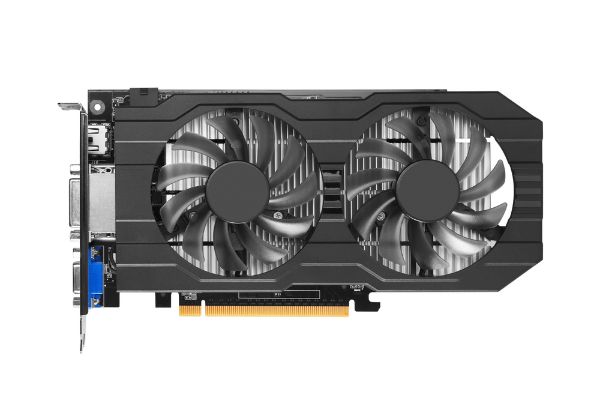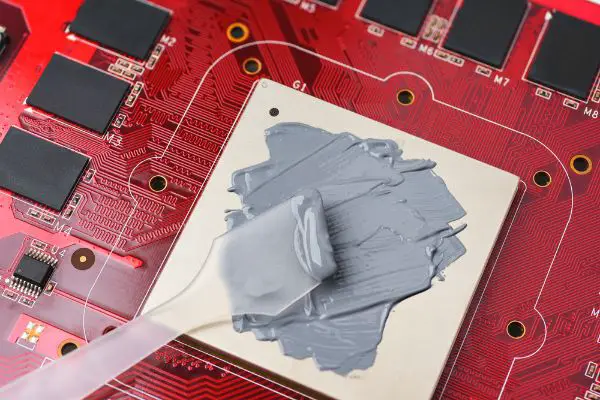Disclaimer: This post may contain affiliate links, meaning we get a small commission if you make a purchase through our links, at no cost to you. For more information, please visit our Disclaimer Page.
Thermal paste is a special putty-like substance that you can mold into a small shape to put inside your computer. Its primary purpose is to help draw heat away from your PC’s central processing unit and the heatsink.
Because your computer works hard, the sensitive parts inside can get hot. Thermal paste provides a way to keep things cool. Some users wonder if they can or should add a bit of this paste to their GPUs, and we will cover this in detail in the sections below.
Table of Contents
Should You Put Thermal Paste on GPU?
You might already know a little about thermal paste if you’ve read up on how central processing units stay cool. However, you might not realize that graphics processing units also need some love.
GPUs share many similarities with CPUs. Over the years, developments in GPUs have made them capable of increasingly general tasks that help the CPU. Their primary focus is heavy rendering for complex graphics, which takes energy. In turn, a GPU can also produce a lot of heat and benefit from the thermal paste.
If you have a new GPU, it probably already came with some thermal paste directly from the manufacturer. So, when asking yourself if you should put thermal paste on the GPU, the answer is that it depends. In use cases, adding additional or different thermal paste to your GPU can be beneficial. We will cover some of these cases in detail.
1. If your rig and graphics card are fewer than 3 to 5 years old, it is unlikely that you need to open it up to add more thermal paste to the GPU. Quality paste should last for at least this length of time.
2. Even if the card and other components are new, it is a good idea to check the internal temperatures of your computer as soon as you can. Doing this can give you an idea of the normal temperature range, and you will know if anything is off in the future. Some apps can test this for you.
3. If temperatures are too high for the GPU, consider cleaning the card and carefully removing dust or other debris that has built up inside. This could be enough to restore temps to a normal range. If not, it is time to consider adding some new thermal paste to alleviate the heat issue.
What Happens if You Put Too Much Thermal Paste on GPU?
Sometimes, we tend to think that more is better. For example, newcomers to thermal paste who want to keep their delicate system parts cool may believe that more thermal paste can provide maximum cooling without any negative effects. However, there is such a thing as too much thermal paste.
1. Beginners and experienced users should follow guides on using a pea-sized amount of thermal paste spread over a thin layer across the appropriate area.
2. Using more than the recommended amount of thermal paste can cause it to glob up or clog the area for which it is meant. In most cases, this will simply get thermal paste on other components and make a mess.
3. In some cases, too much thermal paste might make it hard for the screws on your GPU’s back to having enough pressure to mount properly. You don’t want to screw the GPU back in and close everything up only to realize that the unit is not seated as it should be and could be damaged.
4. Too much thermal paste could be a more serious problem if it is conductive. Super cheap thermal pastes can also have conductive or ineffectual components. However, your paste should not be conductive as long as it is of reasonably good quality. We recommend that you find a mid-range thermal paste.
Will Thermal Paste Hurt Your GPU?
Thermal paste only has one main job: keeping components in your PC cool when they’re working hard. Things like the CPU and GPU will always generate heat, so the thermal paste is good to have on hand.
In nearly all cases, thermal paste will not harm your GPU. We need to cover exceptional situations just so that you’re aware of rare cases where there might be a problem,.
As we mentioned, there are various kinds of thermal paste out there for you to choose. Some of these products are cheaper than others and are all made with similar but slightly different compounds or mixtures.
If you get a cheap thermal paste that is conductive, there is a possibility that it might cause shorts on the components that surround the graphics card. This is a case where you will want to be careful about what type of thermal paste you are applying to the GPU and how much you’ve decided to use.
Do You Always Need To Use Thermal Paste on GPU?
It is more than likely that whatever computer you purchased had thermal paste already applied to the manufacturer’s CPU and GPU. As we have touched on, you probably don’t need to do anything regarding taking apart or pasting anything unless you are noticing suspiciously high temperatures when your PC is either idle or running.
You could install a graphics card without thermal paste if you build your own computer. If you did this, it would be wise to check the idle and running temps regularly to see if there are any significant issues. If things operate within the normal range, your GPU could be acceptable.
However, if you are already putting things together, there isn’t much reason not to add a bit of thermal paste when installing a GPU. It is worth noting that some graphics cards tend to “run hot,” with upper temperature ranges being normal for them. In such cases, some paste to help heat transfer could be even more crucial.
How Often Do I Need To Change Thermal Paste on GPU?
Most thermal paste for newer GPUs should last a minimum of three to five years. However, a good quality paste can last much longer than that. Although some manufacturers might recommend redoing your paste regularly for best results, you might not need to touch it.
A good rule of thumb is to consider replacing your thermal paste if you notice a concrete problem. For example, if your computer seems to overheat even when idle or performing light tasks, the thermal paste may have dried out and become ineffectual. However, it is good to remember that fans or other things could also be the source of the issue.
Bottom Line
Graphics processing units are excellent components that allow for complex, resource-heavy 3D renderings in various professional or entertainment applications. With such a big job, they need ways to stay cool. Thermal paste is one of the best ways computers can draw heat to the heatsink and keep things chilled for those hardworking components.
Most rigs will come with a bit of thermal paste installed, and it should last for several years at the very least. If you’re constructing your own computer, there are best practices for installing the correct type or amount of thermal paste for your GPU needs.
In most cases, thermal paste is only helpful to the GPU and poses no risks, but it is always essential to remember exceptional cases and ensure that there is no mess if you need to perform a reapplication.


